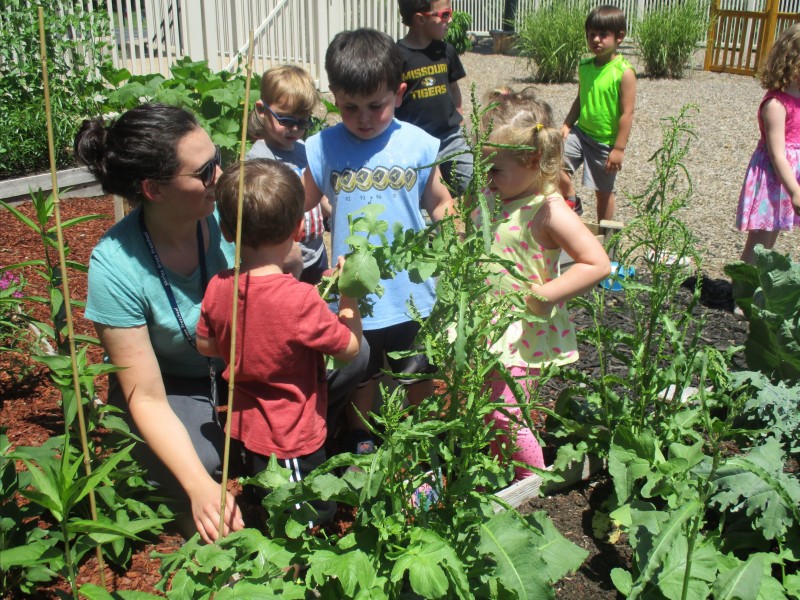A 140 Pound Pot-Bellied Pig Walks Into a Preschool, and…

You might think this is the opening line of a strange preschool joke. It isn’t. It’s from days in the life of Karen Lucy. Karen is the Director of Early Childhood Education in the Shirlee Green preschool at the Jewish Congregation Shaare Emeth in St. Louis, Missouri. And the pig is Millie. When Millie was an adorably cute piglet Karen brought it to her previous preschool. Consumption of pork is prohibited by Jewish dietary laws, so Karen had asked the rabbi if bringing a pig to the preschool was ok. “Where could it be safer?” was the reply. For two years the school raised the pig. Children played with her outside. Families took her home on weekends. And now Millie visits the children at Shirlee Green.
By the end of my interview with Karen I’d been treated to a journey through an engaging world where children develop intellectually, socially and spiritually through interactions with nature that flow from indoors to out. Karen has been using animals in educational presentations for over twenty years, so an animal in her classroom is not just a class pet. When she mixes children with animals and nature, her deep understandings of them all go into the blend.
As we spoke, I kept hearing a profoundly playful and spiritual relationship to animals unfolding in the conversation, so I asked Karen about her childhood. She had grown up in rural southern Missouri, where her father was a farmer and miner.
Large families run in her family; her father had twenty siblings, and Karen was the youngest of ten. “We had very little growing up,” she said, “but I never realized that we had so little. We had one another and we were always outside, always outside. I just had that love [of nature] instilled in me as a child and I hope the same for these children.”
Back at Shirlee Green, children from six weeks to 5 years (pre-kindergarten) attend classes primarily in one wing of the Temple, and use their Outdoor Kitah (Hebrew for classroom) for learning outside. But they can use any part of the building or its large grounds for learning experiences.
Now going into her fourth year at the school, Karen was charged with instituting change when she was hired. Shirlee Green had forty-six students when she started. Today it has one hundred twenty. The school had a traditional playground back then. It has the Outdoor Kitah now.
Karen discovered Nature Explore when our Resource Guide was sent to the school. She had been planning a natural outdoor space, and thought, ‘why not do it in a way that we gain recognition for what we’re doing.’ Participation in last year’s Nature Explore/Outdoor Classroom Project Leadership Institute brought more ideas and engaging contacts. Karen’s Outdoor Kitah has gained recognition among Jewish preschools in the area, and she always recommends Nature Explore to visitors.
The entire Shaare Emeth community, both preschool children and adults, practice “Mindful Teaching.” Intentionality and purpose are the foundations of this form of teaching and learning. Before entering the Outdoor Kitah children stop in the Gathering Area to discuss what they intend to do in the space. This helps them to slow down, to be more aware of nature and to become thankful for this space. They are reminded that this natural area is a blessing that inspires thoughtfulness of action. In Mindful Teaching, Karen says, “There’s always some critical thinking involved.” Children know what they are doing and understand that they are working towards a goal, however brief or long-term. They know they are connected to something larger than just the moment.
“It’s a different generation of parents and also children that are entering our preschool,” she says. “When you have a generation that’s raised with instant gratification and all this technology… I love technology. But like everything, in moderation it’s best. It’s difficult because we as a staff are finding that children are missing a lot of the patience that is needed just to gain focus.” So Karen might prepare the children for entering this special space by asking them what they hear. Yet she doesn’t stop at asking if they can hear the birds, she’ll ask them what they think the birds are saying to them. The children, not wanting to miss these messages, slow down and pay close attention. The message she gives the children is, “You are entering such a sacred place, it is so special that you just have to slow down, and really think about what we’re doing. Listen all the way around, and listen to every animal out there. There are many that you can’t see that are saying something to you, even some below ground.”
Another expression of Mindful Teaching is the connection between preschoolers and the temple congregation through the use of the Mitzvah Garden in the Outdoor Kitah. The Hebrew word ‘mitzvah” means a good deed that is done from religious motivations. Mindful of a responsibility to the larger community, and to those less fortunate, the Congregation Shaare Emeth opens its doors to feed and give overnight shelter to families on the first Monday of every month. Food grown by children in their Mitzvah Garden is either served fresh, or frozen to share on these days. Through their work in the Mitzvah Garden children learn about the life cycle, nurturance and care of living things, where food comes from, and much more. And they also become aware of the spiritual meaning of service that they share, through their garden, with their elders and with the homeless.
In our next blog post, we’ll follow Karen inside. Fasten your seat belts!

